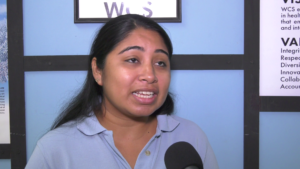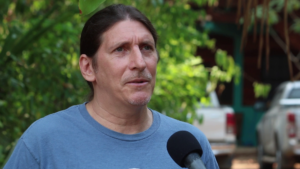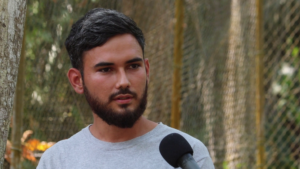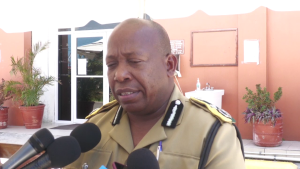Rebuilding the Hicatee Population in Belize Through Captive Breeding
Twelve years ago, one non-profit organization began working on a project to rehabilitate the population of a critically endangered animal in Belize. Today, the Belize Foundation for Research and Environmental Education, BFREE, is leading the charge across the region to prevent the Central American River Turtle or hicatee from going extinct. Culturally, hicatees are hunted by Belizeans for their meat. But studies have shown that overhunting has pushed the species to the brink of extinction. BFREE has established the only hicatee captive breeding facility in the region, and it has proven to be a huge success. News Five’s Paul Lopez travelled south to Toledo District to find out more about their work. He filed the following report.
 Paul Lopez, Reporting
Paul Lopez, Reporting
Did you know that it is illegal to buy or sell the Central American river turtle or hicatees in Belize? Also, a single person can have up to three hicatees, and any female caught must be between fifteen to seventeen inches in size. Hunting this much-sought-after species can only be done outside of the monthlong closed season in May. Hicatees have only been found in three countries, Mexico, Belize and Guatemala. In Belize, it is a traditional delicacy that is highly sought after, especially in rural communities.

Yamira Novelo Fuentes
Yamira Novelo Fuentes, WCS
“Belize is really the only country out of the three that allows legal hunting and consumption of the species. It is critically endangered and that is some of the things people don’t understand or think about when they are doing their hunting practice or consumption.”
 Over hunting has led to a significant decline in the hicatee population within Belize. One non-governmental organization has been working to replenish the hicatee population for the past decade. The staff at the Belize Foundation for Research and Environmental Education or BFREE, located next to the Bladden Nature Reserve, are referred to as hicatee heros. Jacob Marlin, the Executive Director of BFREE. An expedition into the Bladden Nature Reserve, thirty years ago, was the inspiration behind the establishment of the organization.
Over hunting has led to a significant decline in the hicatee population within Belize. One non-governmental organization has been working to replenish the hicatee population for the past decade. The staff at the Belize Foundation for Research and Environmental Education or BFREE, located next to the Bladden Nature Reserve, are referred to as hicatee heros. Jacob Marlin, the Executive Director of BFREE. An expedition into the Bladden Nature Reserve, thirty years ago, was the inspiration behind the establishment of the organization.

Jacob Marlin
Jacob Marlin, Executive Director, BFREE
“We documented quite a lot and saw this was a completely pristine tropical rainforest that had been completely unexplored and unstudied.”
 Since 1995, BFREE has facilitated hundreds of research papers and publications in collaboration with Belizean and foreign students. Of all the current and past conservation projects that BFREE has worked on, its Central American River Turtle or Hicatee Captive Breeding Project is perhaps the most groundbreaking. BFREE has the only hicatee captive breeding facility in the world. Thomas Pop has been managing the project for the past ten years. Barney Hall, a Wildlife Fellow at BFREE, has been working alongside Pop for the past two years.
Since 1995, BFREE has facilitated hundreds of research papers and publications in collaboration with Belizean and foreign students. Of all the current and past conservation projects that BFREE has worked on, its Central American River Turtle or Hicatee Captive Breeding Project is perhaps the most groundbreaking. BFREE has the only hicatee captive breeding facility in the world. Thomas Pop has been managing the project for the past ten years. Barney Hall, a Wildlife Fellow at BFREE, has been working alongside Pop for the past two years.

Thomas Pop
Thomas Pop, Manager, Hicatee Conservation Research Center
“These turtles are very difficult to work with and as you can see here, we don’t have a natural habitat for them but I am trying to make this pond their natural habitat so these turtles can feel comfortable in this area.”
 Jacob Marlin
Jacob Marlin
“Hicatee is very secretive. They spend all their time underwater. They don’t come up on the beaches to lay eggs. They don’t come up to bask. It is a fully aquatic specie, more like a fish and they are very hard to study in the wild.”
The International Union for Conservation of Nature placed hicatees on its red list as critically endangered or facing an extremely high risk of extinction. Studies have shown that the turtle has been virtually eliminated from much of its habitat in southern Mexico. Its status in Guatemala remains unclear and several studies in Belize have shown that the numbers have significantly decreased over the years. These are the only three countries where hicatees can be found. BFREE is on a mission, through its research project, to breed and rewild hicatees in Belize.

Barney Hall
Barney Hall, Wildlife Fellow, BFREE
“We target areas where the species once was, and we try to augment those populations by reintroducing these hicatees back into the wild. But before that we need to have veterinarians come in. They have to test blood, parasites, feces, we don’t want any introduced pathogens back into the wild.”
 At the facility, the hicatees are separated in three different ponds based on their developmental stage. Studies show that it takes a hicatee up to sixteen years to reach the breeding stage. Even more interesting, hicatee eggs go through a process called embryonic diapause which is a temporary pause in an embryo’s development. Essentially, hicatee eggs take up to six months to hatch. To date, BFREE has rewilded more than five hundred turtles with another three hundred eligible for release this year.
At the facility, the hicatees are separated in three different ponds based on their developmental stage. Studies show that it takes a hicatee up to sixteen years to reach the breeding stage. Even more interesting, hicatee eggs go through a process called embryonic diapause which is a temporary pause in an embryo’s development. Essentially, hicatee eggs take up to six months to hatch. To date, BFREE has rewilded more than five hundred turtles with another three hundred eligible for release this year.
Barney Hall
“We have teams like the Savannah Field Station, they are constantly outfield, setting nets, trying to get a population assessment and they have been recapturing some of our turtles and we are seeing that they have been doing very good in the wild. So that is a very good sign.”
 The Wildlife Conservation Society has also been studying the Central American river turtle. For the past three years, they have been doing so in the Maya Forest Corridor in central Belize. According to Yamira Novelo Fuentes, legislative reform is necessary for greater protection.
The Wildlife Conservation Society has also been studying the Central American river turtle. For the past three years, they have been doing so in the Maya Forest Corridor in central Belize. According to Yamira Novelo Fuentes, legislative reform is necessary for greater protection.
Yamira Novelo Fuentes
“I think when it comes to legislation and updating and amendment, I think you do need to take into consideration the community and what they want. Because we can put enforcement and legislation, but if you don’t have that community buy-in and that community who wants to be part of it then you wont be able to have compliance. And you want your communities to be stewards of their resources more than anything else.”
 BFREE has fully embraced the community component of its conservation efforts. Through research on hicatees, the organization has developed several resources that are distributed in primary and high schools across the country. The Adventures of Herbet the Hicatee is one such book. BFREE also organizes presentations with various groups to spread awareness about the critically endangered specie and what communities can do to make Belize a haven for hicatees. BFREE also recognizes October as hicatee awareness month, a practice that began eight years ago. Heather Barrett is the Deputy Director at BFREE.
BFREE has fully embraced the community component of its conservation efforts. Through research on hicatees, the organization has developed several resources that are distributed in primary and high schools across the country. The Adventures of Herbet the Hicatee is one such book. BFREE also organizes presentations with various groups to spread awareness about the critically endangered specie and what communities can do to make Belize a haven for hicatees. BFREE also recognizes October as hicatee awareness month, a practice that began eight years ago. Heather Barrett is the Deputy Director at BFREE.
 Heather Barrett, Deputy Director, BFREE
Heather Barrett, Deputy Director, BFREE
“One of the material we have and we like to use is this one, which just says take the hicatee promise, it is essentially saying I promise to be a hicatee hero and care about the species. I would say like there is, I do think there is hope and I do think the children are buying into this idea that our wildlife in Belize, it is critical to protect it and it is for us, all of us to take a little action whatever it is.”
Reporting for News Five, I am Paul Lopez.







Facebook Comments